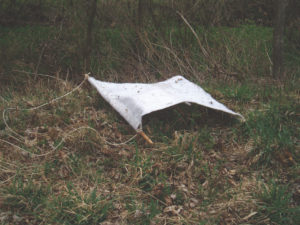 Photo courtesy of the Department of Environmental Protection
Photo courtesy of the Department of Environmental Protection Last year, the Pennsylvania Department of Environmental Protection began a five-year environmental surveillance to discover the possibility of someone contracting tick borne illnesses across the state. This year, the study will continue.
The survey was initiated by the Pennsylvania Lyme’s Diseases Task Force’s recommendations to properly combat the rise in contraction of tick-borne illnesses said DEP Secretary Patrick McDonnell in a DEP press release.
“This survey will provide important data that will help us better understand these arachnids in our environment and inform Pennsylvanians on how, when and where to avoid getting bitten by a disease-carrying tick,” McDonnell said. “We want everyone to enjoy the outdoors and take the proper precautions to avoid contact with ticks.”
The department selected three tick species in different growth times for the survey to focus on, said Elizabeth Rementer, press secretary for DEP: the blacklegged tick in its immature nymphal stage, the adult American dog tick and the adult lone star tick were the selected ticks. These three species are responsible for diseases such as Lyme’s Disease, Rocky Mountain Spotted Fever, Ehrlichiosis and Tularemia.
According to the press release, the blacklegged tick is the primary offender in contracted tick-borne illnesses. This is mainly due to people not knowing the “poppy seed sized” ticks have latched onto them.
“Although we’re focused on the three tick species mentioned,” Rementer said. “We will also be looking at any tick species that we happen to collect. In particular, there are two other tick species that we know are starting to show up in PA: the groundhog tick and the longhorn tick.”
Last year, the first stage of the study was a “preliminary, informal” study, said Rementer. The study will become formal starting with this year’s gathering and testing.
“If we have significant updates, we will provide them as they become available,” Rementer said. “The goal is to go through the five years and [then] publish our findings.”
According to the DEP press release, the ticks are collected with felt drags, which are placed over the ground to catch venturing ticks. So far, 3,663 blacklegged ticks have been collected since the survey started July 1, 2018, Rementer said.
 Photo courtesy of the Department of Environmental Protection
Photo courtesy of the Department of Environmental Protection“We have processes for telling the counties how to collect certain types of ticks,” he said.
To survey the blacklegged tick in its nymph stage, the DEP selected 38 Pennsylvania counties to focus on that species. Every county will survey for the adult American dog tick and the adult lone star tick. The DEP selected Greene County to survey for the blacklegged tick, along with the other tick species.
“We have currently existing contracts with those counties,” Rementer said, “and so we were able to provide them extra funding on existing contracts so that they would be able to do this additional work.”
